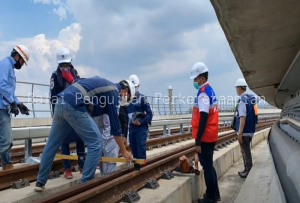Testing Curvature of the Railroad at the Cawang – Cibubur Cross between Cawang Station – Harjamukti Station on the Jabodebek LRT

BEKASI – Railway Infrastructure, in this case, the railroad where the train travels on has a structure which is not always straight, but there are also curves. Curve is an integral part of the components of the railroad, and the curve has special requirements regarding the scales and curvature.
When the train operates through a horizontal curve, a centrifugal force will arise outward, so the outer rail is under greater pressure than the inner rail, and the outer rail wears more than the inner rail, which can result in the train's overturning.
Horizontal curvature is the projection of the axis of the railroad on the horizontal plane. A circular arc must connect two straight sections whose extensions form an angle with or without a transition arc.
A few moments ago, the Railway Infrastructure Testing Team of the Directorate General of Railways of the Ministry of Transportation was assigned to test the document and physical design as well as function tests between Cawang Station and Harjamukti Station on the Cawang - Cibubur route for the construction of the Jabodebek LRT infrastructure. One of the tests carried out is the horizontal bending test.
Parameters that must be considered when testing the horizontal bending are:
- Arrows. To determine the length of the arrow of an arch, you can use a tool in the form of a nylon thread with a fixed length by measuring from the midpoint of the stretch of nylon thread to the inside of the outer rail head. The purpose of using arrow parameters for testing the curve is so that the train travels when entering the curve from a straight line runs smoothly so that it does not cause a drop in the train or other damage to railway facilities and infrastructure.
- The elevation curve of the outer rail is made higher than the inner rail to compensate for the centrifugal force experienced by the train set. Rail elevation is achieved by placing the inner railroad at the proper height, and the outer rail is higher.
- The widening of the track is done so that the train wheels can pass through the curve without experiencing obstacles and so that the railroad and wheels do not wear out quickly. There are 3 (three) factors that greatly influence the size of the gauge widening, namely:
- Curved radius (R).
- Front-rear axle size/distance.
- Wheel and rail wear conditions.
There are 3 (three) horizontal curvature test equipment used by the Railway Infrastructure Testing Team, namely:
- Versine Measurement (nylon thread).
- Track Gauge Measurement.
- Measurement
The results of the tests that have been carried out will be submitted to the Directorate of Railway Infrastructure for further processing of certificate issuance.
PUBLIC RELATIONS - RAILWAY TESTING CENTER



_(2).png)
_(3).png)
_(740_×_322_piksel).png)
_(2).png)
Komentar
LOGIN FOR COMMENT Sign in with Google